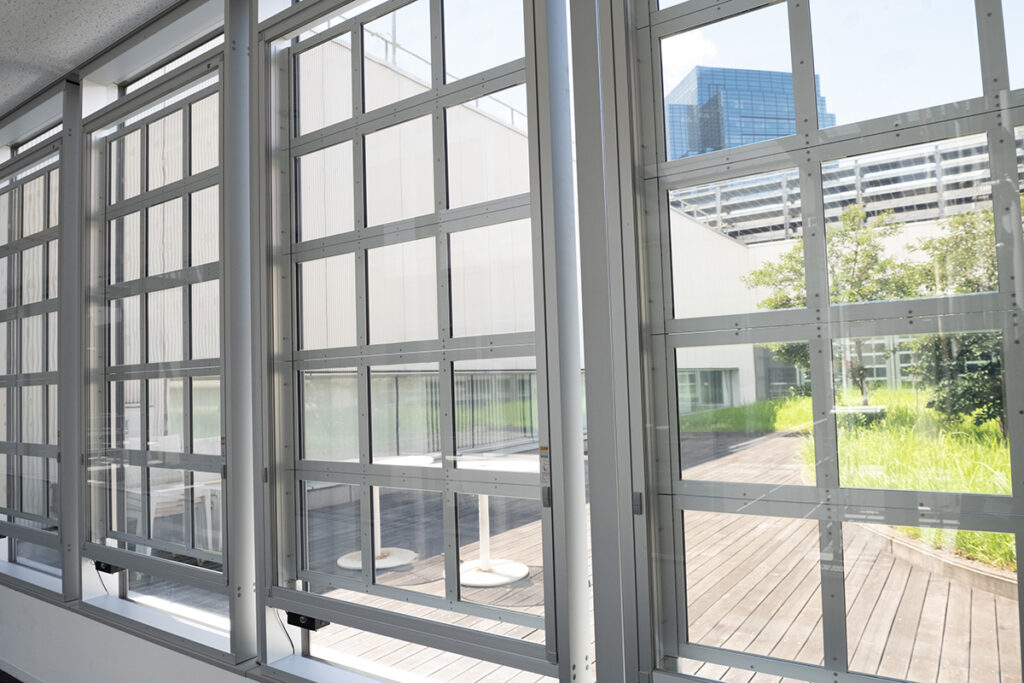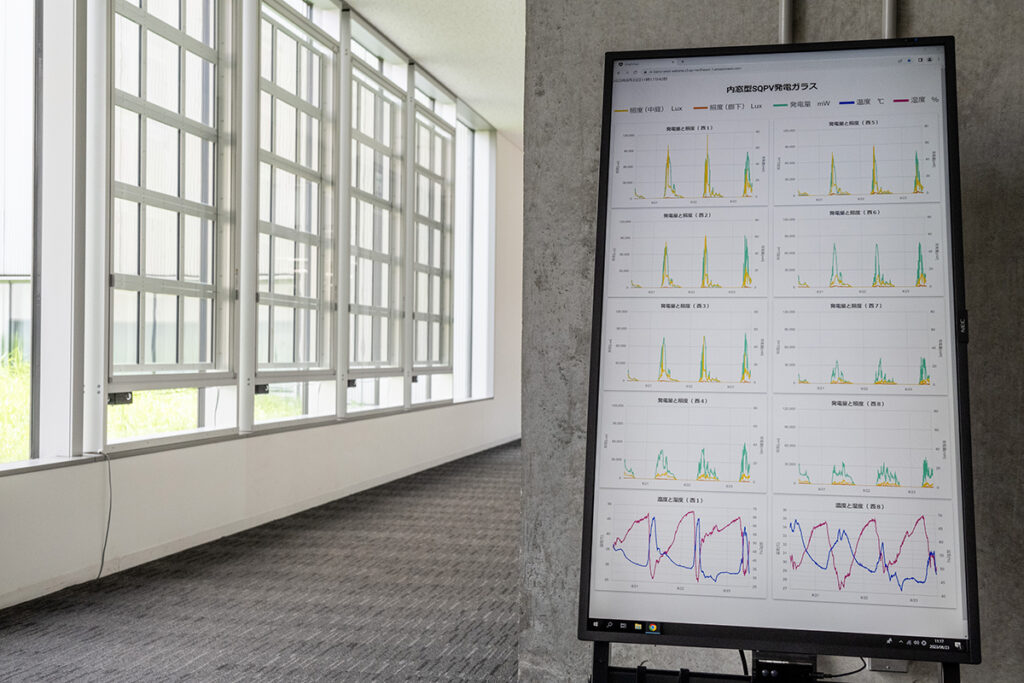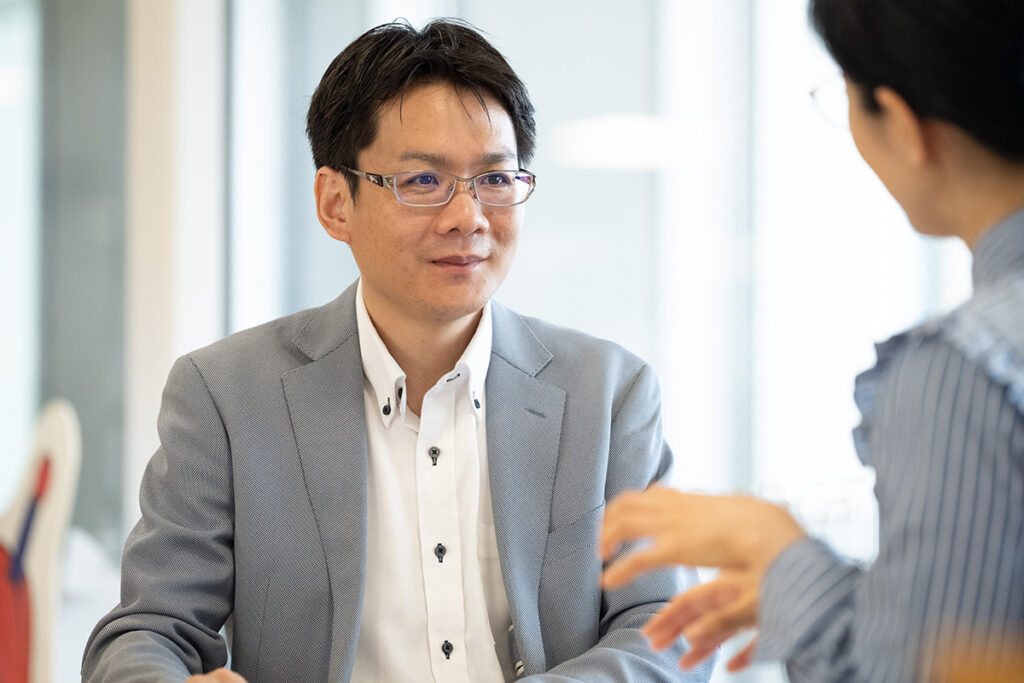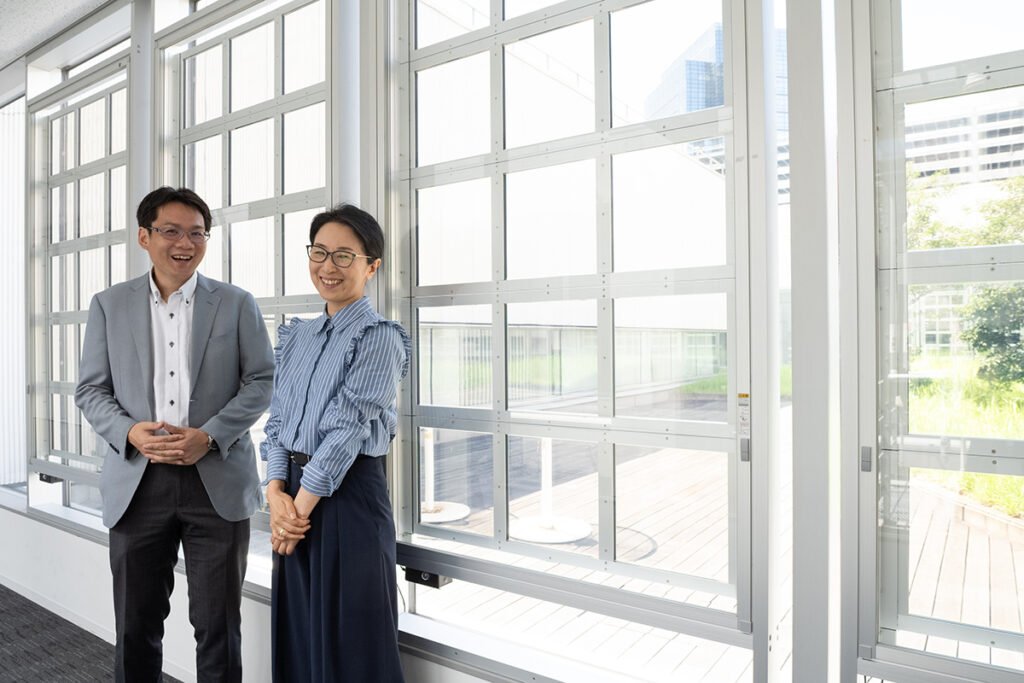

inQs Co., Ltd., a member of the Tokyo Consortium, is a venture company that realizes the creation of locally produced and locally consumed energy using special "colorless transparent photovoltaic glass." In this conversation, Masanobu Kumeta, who is in charge of inQs at the Tokyo Consortium Deep Ecosystem and has been supporting the company as an escort, spoke to President Tomoko Ito about the appeal of the product and future business prospects.
*"Deep Ecosystem" is a unique initiative of the Tokyo Consortium that selects startups that are expected to grow rapidly in the future, with an eye toward overseas expansion, and provides intensive support to help them grow into unicorns. For the selected companies, we will utilize the Tokyo Consortium's concentration and network, including Tokyo Consortium members, domestic and overseas business companies, venture capital, and institutional investors, with an eye to expanding not only domestically but also overseas. Support is provided by diverse members.
Kumeda:First of all, could you tell us about President Ito's career and how he started his business?
Ito:When I was a student, I belonged to the Department of Electrical Engineering in the Faculty of Science and Technology, and was conducting research and development to promote the practical application of high-temperature superelectric bodies. There, I was exposed to complex raw materials and experienced the difficulty of practical application, which sparked my interest in practical applications that can be used in the world, and I joined a trading company to spread the technology around the world. After that, in order to acquire more necessary skills, I entered the International Institute of Advanced Technology to study. So, as we were conducting research to create things that would be useful to the world using waste materials, we discovered that a certain special raw material is a substance that generates electricity when exposed to light, and we used that technology to create spin-offs. inQs Co., Ltd. is out.
Kumeda:They discovered a substance that generates electricity rather than conducts electricity.
Ito:that's right. A photovoltaic material that generates electricity when exposed to light.
Kumeda:After finding the substance, what kind of difficulties did you face before commercializing it?
Ito:When we thought about how best to take advantage of the characteristics of materials that generate electricity with light, we came to the conclusion that in the future we would need a system that can generate electricity in a familiar place and use it on the spot. I did. The idea behind inQs' main products, ``SQPV'' and ``SQ-DSSC,'' was to turn this into a ``photovoltaic device'' and make it useful to the world.
I still remember clearly that we applied for a patent for this technology on March 2011, 3, the day the Great East Japan Earthquake occurred. In the end, I was able to apply, but since it was an electronic application, I remember having some trouble with communications and power outages. At that time, I realized the importance of a system that allows us to generate and use electricity on the spot, and I wanted to put this technology into practical use as soon as possible.
Kumeda: Generating electricity with light means that electricity can be produced locally for local consumption, right?
Ito: As you say. I think mega solar projects are necessary, but I think it would be better to have a system where electricity can be generated where you want it to be used and used on the spot, rather than generating large amounts of electricity and transmitting it from far away through power lines. I am. inQs has created a specialized photovoltaic energy harvesting technology for this purpose.I want to go.

Kumeda:We would like to ask you more details about “photovoltaic elements.” First of all, could you please introduce the business details of inQs?
Ito: We develop and provide photovoltaic devices that generate electricity from unused light. Even in low-light conditions, electricity can be generated as long as there is light. We also use environmentally friendly raw materials. We do not use any lead or cadmium, and the main raw materials can be procured in Japan, which is a feature that existing silicon solar cells do not have.The strength of our business is that we can provide environmentally friendly products. It has become.
Kumeda:It is important from the perspective of energy security that not only light but also materials can be produced and consumed locally in Japan. Could you please tell me more about the difference between silicon-based solar cell power generation and inQs' photovoltaic elements, as you mentioned earlier?
Ito: Existing silicon solar cells refer to the solar panels that you imagine when you hear the word solar power generation. This is the type that generates electricity by facing directly into the sunlight, rather than being completely black and letting light pass through to the other side. In contrast, inQs' photovoltaic devices can generate high output power even from oblique light, regardless of the angle of incident light. Another big difference is that because it uses a glass substrate, it can generate electricity from both sides. Another great feature is that it can generate electricity with high efficiency even in low light conditions such as room lighting.
There are two main types of photovoltaic devices provided by inQs. One is ``SQPV,'' which can generate electricity even when it is colorless and transparent. The other is ``SQ-DSSC,'' which can efficiently generate electricity even in extremely low light conditions, such as in a dark room. "SQPV" also has a heat shielding effect, so it can be called "eco-friendly glass" that can generate electricity and shield heat at the same time. On the other hand, "SQ-DSSC" can generate electricity at a fairly high output even in dark places, so it has the advantage of being able to continue supplying electricity to items that used to be powered by dry batteries without having to replace batteries.
Kumeda: Since "SQPV" is transparent glass, it can be used as is in the windows of high-rise buildings and residences.
Ito: As you say. In addition to using it on the outside of high-rise buildings like a curtain wall, we recommend installing it inside as an internal window so that electricity can be obtained closer to home. Regarding "transparency," its major feature is that it can be placed without compromising daylight, which is something that was difficult to develop. I think it's important that it doesn't feel out of place even if it's installed in the room. A unique advantage of transparent materials is that they can generate electricity not only from sunlight but also from indoor fluorescent lights.
Kumeda: By attaching it to the internal windows of an office building, you can get a heat shielding effect and also get electricity, so by supplying power from there, you can create something like an eco-friendly smart building. If we tried to do this with black silicon solar cells, buildings and houses would turn completely black.
Ito: Well, I don't think it gives a very good impression on the outside. The visible light transmittance, which indicates transparency, is over 70%, and we are proud that the power generation efficiency is the highest in the world.
Kumeda:I feel that the other "SQ-DSSC" also has potential. As long as there is even a little light in the room, the sensors can be activated. I think demand will increase as there is a trend in the EU to eliminate dry cell batteries.
Ito: In Europe, talks have begun to reduce so-called disposable energy such as dry cell batteries, and energy harvesting technology is attracting attention. There is always light wherever people live. inQs' photovoltaic elements can reuse not only sunlight but also such light to generate electricity on the spot. I would like to further spread this kind of photovoltaic energy harvesting technology.

Kumeda: inQs has been participating in the Tokyo Consortium's deep ecosystem since September last year.
Ito: By participating in the Deep Ecosystem, we have been able to take advantage of a wide range of networks, receive advice, and participate in exhibitions, among other initiatives. Until then, we had thought that we were the best at understanding our company's strengths, but being able to recognize the appeal of our products from a broader perspective was a huge benefit. think. I also felt that if inQs' technology is used more often, not only in Japan but also around the world, it will be of great help in contributing to society.
Kumeta: Thank you. Could you tell us specifically what kind of support you have received?
Ito: We are brushing up our business plans, etc., and we would like to receive suggestions from a new perspective, including the market environment and social situation, regarding what steps we should take in designing the processes necessary for our future vision. I did. It was very helpful to be able to build up the process based on specific advice such as ``How about exhibiting at this kind of exhibition?'' and ``How about finding this kind of partner?''
What's also very appealing is that they don't just make suggestions, but also work together to put them into practice. We were given a place to exhibit and speak at one of Japan's largest startup events called "City-Tech.Tokyo," and at that time, we were given specific and polite comments such as, "It would be great if you could highlight these points." Thank you for your guidance.
In addition, when we were installing inQs products at the Tokyo Metropolitan Industrial Technology Research Center, they helped us with the preliminary survey and traveled with us. They really worked hard together with us. I did.
Kumeda: Mr. Ito would also like to introduce us to the installation of products from the Tokyo Metropolitan Industrial Technology Research Center. It all started when I appeared on stage at ``UPGRADE with TOKYO'' held last year and won.
Ito: We won in the "Create (T)" category of the "HTT" project ("Reduce (H)", "Create (T)", and "Save (T)" energy) promoted by the Tokyo Metropolitan Government. I did. Although it is difficult to generate energy in cities, there is still a lot of unused energy. inQs' efforts to create energy by focusing on unused light were recognized.
Kumeda: Could you please tell me what the purpose of "SQPV", which was established from March 2023, is?
Ito:First of all, we installed it to let people know about "transparent photovoltaic glass" called "SQPV". SQPV photovoltaic glass, which can also be used as a partition, looks like ordinary glass at first glance, but we installed it in a natural exhibition format to show that it can generate electricity even with the lighting inside the room.

Kumeda:In July, an internal window type "SQPV" was installed. Could you also tell me its purpose?
Ito:This "SQPV" transparent photovoltaic glass was installed from the inside of the 5 windows on the 16th floor of the Tokyo Metropolitan Industrial Technology Research Center. We are able to obtain raw data that cannot be obtained through testing, such as how much electricity can be generated from the light energy obtained in actual living environments through power generation through double-sided light reception on photovoltaic glass. We also believe this is a good opportunity to let the public know that it can be installed and removed from existing buildings at a later date.



Kumeda:Currently, it is recommended to use "SQPV" transparent photovoltaic glass for interior windows, but in the future, will it be possible to use "SQPV" for exterior windows of newly built offices and residences? Is it?
Ito: It is also possible to provide it as part of the structure of a building, such as walls or windows. We are currently starting with interior windows to take a step forward, but technologically speaking, we are already progressing with development to install it in newly built windows. Simulation results show that replacing regular window glass with SQPV has the effect of reducing air conditioning costs by approximately 4%.
Kumeda: Where do you think the demand for SQPV from private companies lies?
Ito: inQs is focused on the local production and local consumption of unused energy, which is called energy harvesting technology. Glass is used all over the world, so we believe there is immeasurable demand for SQPV transparent photovoltaic glass, which can generate electricity on the spot using light. In Europe and the United States, the market for renovations to environmentally friendly, high value-added glass is already expanding due to legal regulations. Although there are heat shielding and insulating window glasses available in the world, transparent glass that can also generate electricity is not yet available in society, so I think this will lead to demand for products with added value that differentiate them from others.
Furthermore, if the generated electricity is stored, its uses can be expanded infinitely depending on the customer. I believe that there will be a very attractive market for this applied use value in the future.
Kumeda:With that in mind, what issues do you feel are currently facing you?
Ito: I believe that by explaining the product through careful demonstration, people will be able to feel the value of using the product, but the challenge is how to speed up this process.
Kumeda:What do you think is necessary to spread "SQPV"?
Ito: Sharing the value of use. To this end, we are accumulating data on power generation and the energy-saving effects of heat shielding. The light energy that is the basis of power generation obtained in actual living environments is diverse, such as light that enters from an angle, light reflected from building window glass, illuminations, and street lights.In fact, high output values can be obtained even in dark light. I've also come to understand that it can happen. By combining the electricity obtained from this with other solutions such as power supply for sensors, we would like to create a product that provides unsung support to create a better living environment.
Kumeda:It seems possible to use the generated electricity to control the air conditioners throughout the building.
Ito:For example, if the air conditioner is too strong in the back of the room and it is cold, while people in the front are too hot, the system uses generated electricity to sense the environment in the room and control the air conditioning more precisely. I think you can.
Kumeda: There is a limit to how much wiring can be laid out, so it seems possible to operate various sensors by pasting ``DSSC'' on the ceiling, which can be used even in low light, or by installing ``SQPV'' on the windows.

Kumeda:What are your thoughts on overseas expansion?
Ito:We are actively working to bring technology developed in Tokyo to the world. We are currently at the stage of making plans for business partners and sales expansion.
Kumeda: I would definitely like to establish a mass production system so that we can export Japanese technology.
Ito:I think this technology has the potential to help Japan become an energy exporter, so I want to do my best. In the future, the ideal future would be to make it a portable energy source that can be easily carried around like a cell phone.
Kumeda:I also feel that SQPV's transparent photovoltaic glass has great potential. You can't stick black silicon solar cells on the windows of buildings and houses, whether indoors or outdoors. In fact, there is a prospect that the cost will be reduced considerably in the future, and if it is mass-produced, it may spread rapidly. Currently, we are at the stage of using it for interior windows and collecting data, but in the future, SQPV's transparent photovoltaic glass will be used in all the windows of newly built houses and 30-story buildings. I can see the future. We would like to support a future in which Japanese technology is exported not only domestically but also to the world. Lastly, do you have a message for startup managers who are thinking of applying to the Tokyo Consortium's Deep Ecosystem?
Ito: Creating new innovations and building new business models is not easy, but the only way to seize that opportunity is to take action. The world expands by receiving support from the deep ecosystem. I would like to see you start up as a start-up company.

Tomoko Ito
inQs Co., Ltd.
After graduating from university, he joined Sumitomo Corporation. After that, he served as Managing Director and CTO at the International Advanced Technology Research Institute, which conducts development projects that connect technology from seeds to needs, and spun off with photovoltaic device technology to establish inQs, Inc. He is up to the present.